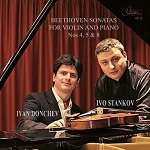|
Back
11/29/2013
Ludwig van Beethoven: Sonatas No. 4 in A Minor, Op. 23, No. 5 in F Major, Op. 24, & No. 8 in G Major, Op. 30 No. 3 for Violin & Piano
Ivo Stankov (Violin), Ivan Donchev (Piano)
Recorded at the Vatican Radio, Rome, Italy (January 7, 8, 2013) – 60’52
Gega New Reference # GR 18 – Booklet in English, Italian, and Bulgarian

Beethoven’s violin sonatas have sometimes been given rather short shrift by some learned musicological minds. Even in the composer’s own time, critics generally remained unenthused about his efforts in the genre until the premiere of Sonata No. 4 in A minor, in 1801.
It is that Sonata No. 4 that initiates this new recital on Gega New, joining the Sonata No. 5 in F major, and Sonata No. 8 in G major, which originally appeared in 1801 and 1803 respectively. Given the delightful performances rendered here by violin virtuoso Ivo Stankov, and his sensitive collaborator, pianist Ivan Donchev, one cannot help but wonder if Beethoven’s first three sonatas might have engendered a more positive stir had they been fielded by such a lively team.
One of the noteworthy Bulgarian artists of his generation, Stankov has largely established his center of musical operations in London, where he has won acclaim in such disparate venues as Wigmore Hall and the more “popular” orchestral pits of the West End; notably in such viscerally roughish scores as that for the musical Chicago. Perhaps it is that theatrical experience that gives Stankov’s traversal of these sonatas such verve. These are very spirited performances, yet at no expense of caressing lyricism, and the pieces are dispatched with consistently impressive, polished legato from Mr. Stankov throughout.
The joie de vivre of this disk (as well as the fluidly responsive pianism of Donchev, a pupil of Aldo Ciccolini) announces itself straight away in the opening Presto of the No. 4. The Andante scherzoso which follows boasts an appealing and requisite gossamer touch from both performers, particularly in the lightly teasing manner with which Donchev strokes the keys here. The final Allegro Molto, with its fleeting references to Mozart’s Jupiter symphony, closes the sonata gracefully. It can be difficult for American audiences in particular to hear the opening Allegro of Sonata No. 5 without thoughts naughtily wandering to memories of the 80’s teenage artistic angst film Fame, but the gentlemen quickly obliterate such flashy-trash associations with their committed reading. The interplay of grace and verve on the final Rondo is especially charming, and the Allegro Vivace which concludes the Sonata No. 8 to follow may be the most buoyant cut on the disk, and brings the recital to a satisfying conclusion.
The accompanying booklet is not extensive in terms of documentation, but it doesn’t register as a sad budget job either. Brief biographies of both performers are included, as well as an informative interview concerning their work on the sonatas by BBC Music Magazine’s Jeremy Pound. It is worth observing too that the notes inform us the sonatas are performed on violin Joseph et Antonius Gagliano, Anno 1757, generously provided to Stankov by Sadler’s Wells.
When I first received this disk, I popped it into the CD player in my car to enjoy during a morning commute. It has been a frequent driving companion since.
Mark Thomas Ketterson
|